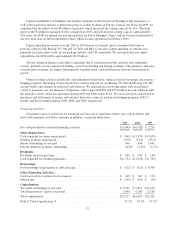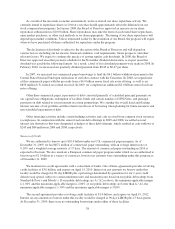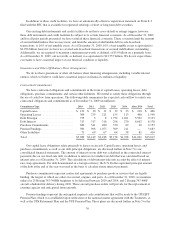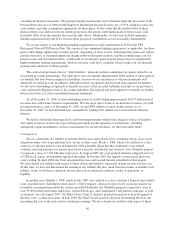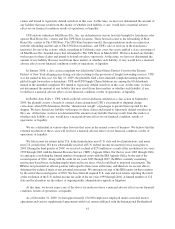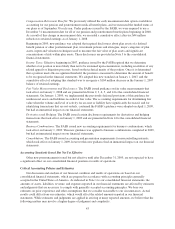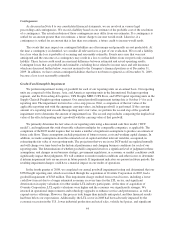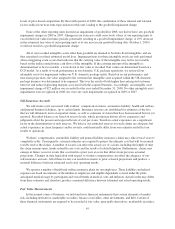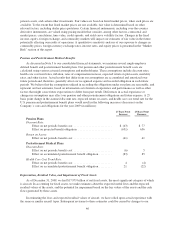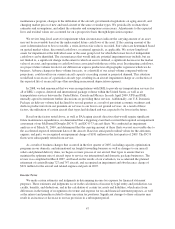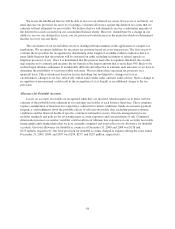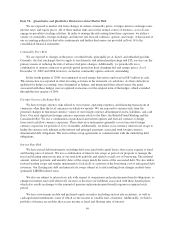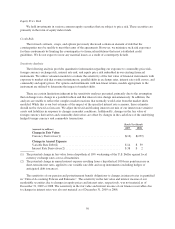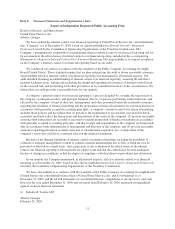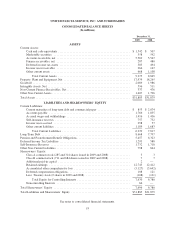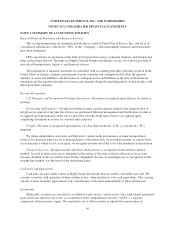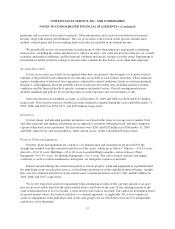UPS 2009 Annual Report Download - page 59
Download and view the complete annual report
Please find page 59 of the 2009 UPS annual report below. You can navigate through the pages in the report by either clicking on the pages listed below, or by using the keyword search tool below to find specific information within the annual report.maintenance program, changes in the utilization of the aircraft, governmental regulations on aging aircraft, and
changing market prices of new and used aircraft of the same or similar types. We periodically evaluate these
estimates and assumptions, and adjust the estimates and assumptions as necessary. Adjustments to the expected
lives and residual values are accounted for on a prospective basis through depreciation expense.
We review long-lived assets for impairment when circumstances indicate the carrying amount of an asset
may not be recoverable based on the undiscounted future cash flows of the asset. If the carrying amount of the
asset is determined not to be recoverable, a write-down to fair value is recorded. Fair values are determined based
on quoted market values, discounted cash flows, or external appraisals, as applicable. We review long-lived
assets for impairment at the individual asset or the asset group level for which the lowest level of independent
cash flows can be identified. The circumstances that would indicate potential impairment may include, but are
not limited to, a significant change in the extent to which an asset is utilized, a significant decrease in the market
value of an asset, and operating or cash flow losses associated with the use of the asset. In estimating cash flows,
we project future volume levels for our different air express products in all geographic regions in which we do
business. Adverse changes in these volume forecasts, or a shortfall of our actual volume compared with our
projections, could result in our current aircraft capacity exceeding current or projected demand. This situation
would lead to an excess of a particular aircraft type, resulting in an aircraft impairment charge or a reduction of
the expected life of an aircraft type (thus resulting in increased depreciation expense).
In 2008, we had announced that we were in negotiations with DHL to provide air transportation services for
all of DHL’s express, deferred and international package volume within the United States, as well as air
transportation services between the United States, Canada and Mexico. In early April 2009, UPS and DHL
mutually agreed to terminate further discussions on providing these services. Additionally, our U.S. Domestic
Package air delivery volume had declined for several quarters as a result of persistent economic weakness and
shifts in product mix from our premium air services to our lower cost ground services. As a result of these
factors, the utilization of certain aircraft fleet types had declined and was expected to be lower in the future.
Based on the factors noted above, as well as FAA aging aircraft directives that would require significant
future maintenance expenditures, we determined that a triggering event had occurred that required an impairment
assessment of our McDonnell-Douglas DC-8-71 and DC-8-73 aircraft fleets. We conducted an impairment
analysis as of March 31, 2009, and determined that the carrying amount of these fleets was not recoverable due to
the accelerated expected retirement dates of the aircraft. Based on anticipated residual values for the airframes,
engines, and parts, we recognized an impairment charge of $181 million in the first quarter of 2009. The DC-8
fleets were subsequently retired from service.
As a result of business changes that occurred in the first quarter of 2007, including capacity-optimization
programs in our domestic and international air freight forwarding business as well as changes to our aircraft
orders and planned delivery dates, we began a review process of our aircraft fleet types to ensure that we
maintain the optimum mix of aircraft types to service our international and domestic package businesses. The
review was completed in March 2007, and based on the results of our evaluation, we accelerated the planned
retirement of certain Boeing 727 and 747 aircraft, and recognized an impairment and obsolescence charge of
$221 million for the aircraft and related engines and parts in 2007.
Income Taxes
We make certain estimates and judgments in determining income tax expense for financial statement
purposes. These estimates and judgments occur in the calculation of income by legal entity and jurisdiction, tax
credits, benefits, and deductions, and in the calculation of certain tax assets and liabilities, which arise from
differences in the timing of recognition of revenue and expense for tax and financial statement purposes, as well
as the interest and penalties related to these uncertain tax positions. Significant changes to these estimates may
result in an increase or decrease to our tax provision in a subsequent period.
47


